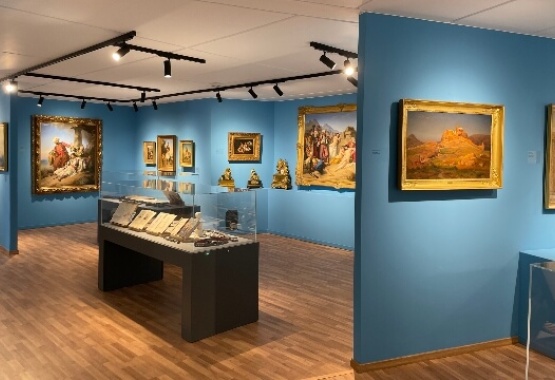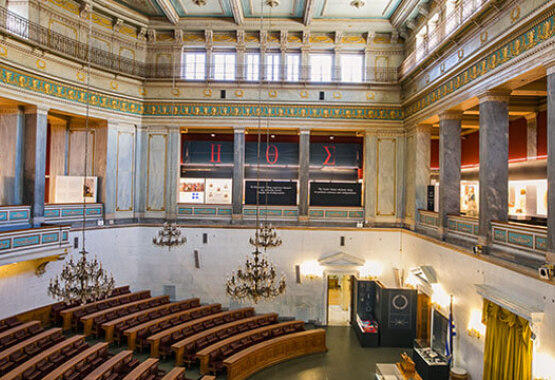
ATHENS
Today, over 3,000 artefacts of Cycladic, Ancient Greek and Cypriot art are on display on four floors, in the galleries of the Museum, a living cultural space in the heart of Athens. One of the Museum wings that hosts temporary exhibitions is the Stathatos Mansion (1 Irodotou & Vas. Sofias Ave), one of the best examples of neoclassical architecture in Athens, work of the Bavarian architect Ernest Ziller. A glass-covered passage connects Stathatos Mansion to the Permanent Collections building at 4 Neophytou Douka Str.
General view of the permanent exhibition “Scenes from daily life in antiquity”
Museum of Cycladic Art
Female figurine. Marble. Early Cycladic II Period (ca. 2800 – 2300 B.C.) It all began in the 1960s, when Nicholas and Dolly Goulandris began to collect ancient artefacts and Cycladic figurines. As time went on, the collection increased in size and travelled to important museums all over the world. The Museum of Cycladic Art opened its doors to the public in January 1986.Today, over 3,000 artefacts of Cycladic, Ancient Greek and Cypriot art are on display on four floors, in the galleries of the Museum, a living cultural space in the heart of Athens. One of the Museum wings that hosts temporary exhibitions is the Stathatos Mansion (1 Irodotou & Vas. Sofias Ave), one of the best examples of neoclassical architecture in Athens, work of the Bavarian architect Ernest Ziller. A glass-covered passage connects Stathatos Mansion to the Permanent Collections building at 4 Neophytou Douka Str.
Cycladic Art Collection
The Museum’s Collection of Cycladic Art, one of the most important in the world, is a pole of attraction for young and old alike. The austere marble figurines depicting nude figures of humans enchant visitors with their simplicity and abstraction – features that have, indeed, inspired 20th-century artists such as Brancusi, Modigliani, Giacometti, Barbara Hepworth, Henry Moore and others.Ancient Greek Art Collection
A synthetic approach to the history of the Aegean societies from 2.000 BC to the 4th c. AD. With the aid of about 350 exhibits and interactive applications, visitors can follow the most important social and political developments from the birth of ancient Greek civilisation down to its creative blending with the Roman tradition, as reflected in constant changes in art and ideology. Part of the exhibition is devoted to ancient Greek technology.Th. Zintilis Collection of Cypriot Antiquities
The Thanos N. Zintilis Collection of Cypriot Antiquities, one of the most important private collections of Cypriot antiquities in the world, includes about 400 artefacts made of stone, clay, bronze, silver, gold, glass, and faience are on display, representing a broad spectrum of Cypriot civilisation from the Chalcolithic period (4th millennium BC) down to Early Byzantine times (6th c. AD).General view of the permanent exhibition “Scenes from daily life in antiquity”




